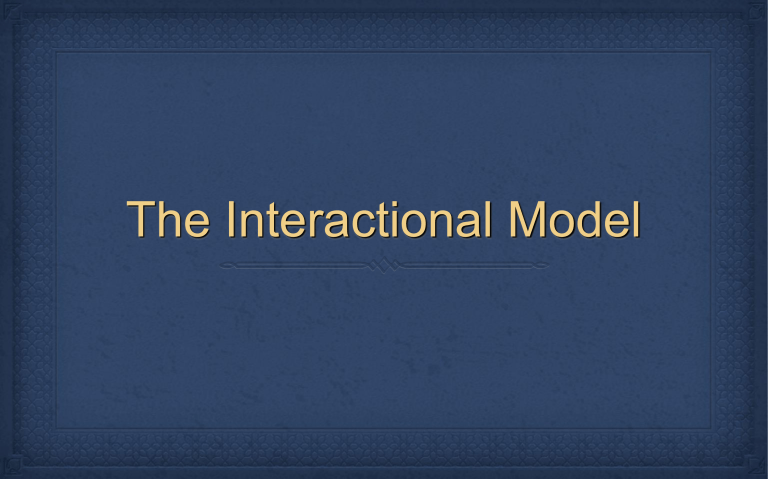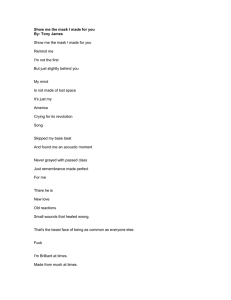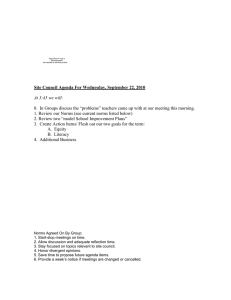The Interactional Model

The Interactional Model
Model Adopted from Yalom
Arose out of Harry Stack Sullivan ’s Interpersonal
Psychiatry
Jerome Frank ’s Work (Psychiatrist / Psychotherapist)
Yalom ’s Basic Tasks
Ensure the physical survival of the group
Build a group culture and establish therapeutic norms
Teach and model for the group members in the here and now work in the group setting
Building a Group Culture: Establishing Group
Norms
Crucial to the Interactional model is the creating an atmosphere where group members feel free to comment on the immediate feelings they experience toward each member and toward the leader(s) in the group
Six Essential Norms
1.
Honest and Spontaneity encouraged and sanctioned
2.
Ensure high level of involvement from all participants
3.
Self-disclosure model (reciprocal vulnerability)
4.
Establishing nonjudgemental acceptance of other group members ’ shortcomings, personal failings
5.
Instillation in every group member of the desire for selfunderstanding
6.
Recognition of dis-satisfaction with self experienced desire to change dissatisfaction and behavior related to encouraged
Development of these Norms
Predispose...
Group members discard social norms that they have been conditioned by
Try new behavior and take risks with there interactions with other group members
Leader Modeling
Leader model setting outside norm (break thru) superego
Leader as trickster
How leaders deal with there own anxiety, anger, and frustration clear message how these emotions will be dealt with by members in the group
Balance honesty with responsibility - being honest is not an excuse for vicious attacks
Mirroring Interpersonal Honesty and
Spontaneity
“Honesty with bad intentions is worse than a lie”
Leader self-disclosure - will it help the group? (Let ’s chat about this)!
Timing of interpretations (making safe to disclose and tell secrets)
“ holy insecurity and the narrow ridge ” (no absolute knowledge)
Model and acknowledge: leader is not perfect, does posses traits that are not always admirable, while also acknowledging that he/she is can accept these traits
Establishment of Group Norms:
Critical Questions and Meta-disclosures
Self-monitoring in group - group members taught to be coleaders, monitor their own interpersonal and between member disclosures
Group must be pushed to evaluate and reflect on itself
Establishment of Group Norms:
Critical Questions and Meta-disclosures
(cont).
Questions for evaluation and reflection
1.
I see a half hour has gone by and how has the group done today?
2.
Is each of you satisfied with its direction and content? If not, why haven ’t you said anything?
3.
What could you have done differently?
4.
What stopped you from taking action?
5.
How would you rate group on a scale between 1 and 10 - how would you rate yourself?
Big Secrets and Metadisclosures
Group ’s big secrets (when and how to handle these)...
Group goes only as far and as deep as its most guarded member
Not forced confessional
Meta-disclosures (talking around big secrets, working up to them
For example, tell what is so scary if you reveal? Who might you be worried about? What do you think you might feel? Who do you think might judge you?
What is the worst thing that might happen if you shared?
Norm of Self-Disclosure
Encourage group members to break thru anxiety and share fears, anxiety, irrational and rational thoughts, and big secrets.
Watch seduction of self-disclosure
Our model we are working with focuses more on the process of disclosure on the macro level for the person not so much the content of the disclosure
Climate and atmosphere (corrective emotional group experience coupled with catharsis and working thru of character attachments and defects)
Norm of Self-Disclosure
No dirty fighting
Encourage group members to share about their own reactions to conflict between members and developing coalitions or reactions to distant members
In all we are trying all to be real with ourselves and with others in the group and change or act differently that our primary attachment group from the past
Loved and accepted for who we are instead of trying to act a particular way to be love, feel part of, accepted, and in turn love ourselves
I am worth something if I am real!
Anti-Therapeutic Norms and
Procedural Norms
• Anti-Norms
Careful with take turn formats (anxiety, one upping)
One topic format
Coalitions
Too leader-centered
One-sides (all loving all attacking)
• Procedural Norms
Stress importance and commitment
Stress tardiness, attendance, members are responsible to one another
Make connections between stories / point out dissimilarities
Here and Now
Activation and Process
Illumination
Process and Intrapsyhic
Focus
Group leader ensures group members focus their attention on their immediate feelings and thoughts toward the other group members, the group leader, and the group as a whole.
Immediate events in the group take precedence over the events in the past or current life of each member outside the group
Here and now events primary for group leader
We must remember though that events outside group can shape present behavior, feelings, and thoughts
Getting Inside Social
Macrocosm
Individuals behavior outside will mirror inside - this is what we are trying to change
Achilles heel of each individual group member will emerge in the here and now process
Here and now requires us to examine: 1) content (current feelings of group members, and 2) process (reflective examination of what has occurred sequentially)
The Content
Experience of events understood, felt, and realized by all group members
Paying attentional to behavioral domain, cognitive, emotional, spiritual, etc.
How the individual understands themselves, while paying attention to how each individual interprets and understands events - are we seeing the same thing!
Process: The Big-gee... No Not
Boogey
Group taught and guided to reflect back on itself and understand it ’s own transactions
For instance, examine reasons Joe responded to Mary and not to Bill at this particular time in this particular manner.
Why does Barbie pick only men to respond to and does not respond to members in the group who might be most helpful
Why does Sharon make a broad, general statement such as “I trust everyone” at a time when Sandra is talking about her fears of being judged?
This is the process of illumination - in the here and now!
Leader teaches and models this - the what and the why of now - communication about the communication
Here and Now Techniques
Watch that not to much time is spent on there and then allow there and then, but shift theme of there and then into the here and now with members
Continually think about - the why of the question, why now, what is the question really about, how is about an unconscious projection into the here and now.
Parallels and unconscious repression - uncoded disguises
Here and Now Techniques
“Here and then” talk about father, brother, mother, lover, sister, turn into “here and now ” talk - who in the group reminds them of the latter and then process feelings / thoughts, behaviors
Individual Disclosure Challenge: Point out
Members
Turning the talk of one individuals ’ disclosure about the group as whole (not taking it serious) into challenging member to disclose and point out the group members who maybe not taking group serious
Every there and then experience is encouraged to be turned back to group members - into here and now) who may and often do represent persons outside
Here and now elucidation of individual members feelings and thoughts about each member
(making the rounds), who is the most engaged? Who is somewhat engaged? Why do you think doesn ’t care?
All here and now illumination are made discerning group ’s level of development
Ultimate Goal the Interactional Model
Utilizing the IM model- we are not striving for perfection, but instead engendering one that functions well enough to bring about trust in which each members inter and intra PSYCHIC microcosm will come to life.
Here then the leader and group can begin to help group members understand how their behavior and sense of self impact themselves, group members, and the group as a whole for better of for worse.
Watch the “one or two” members don’t play “I don’t feel safe card ” and try to pull other members into their anxiety gig - safety is also about how we accept ourself - the leader can ’t make you feel safe about how you feel about yourself!!!!
IM and Interpersonal Change:
Sullivan ’s Theory
1.
Personality almost entirely a product of a person ’s interaction with others
2.
As human beings, our need to be closely related to others is basic
3.
As a young developing child, we seek approval of others and avoid their disapproval
4.
Concept of self (self-dynamism) is developed based on our perceived approval or disapproval of others
Yalom-Sullivan Behavioral
Underpinnings
Parataxic distortions - related others based on distortion of reality (human trait)
Distortions are self-fulfilling (perceive ourselves as inadequate) perceive others as harsh and judging, we will then develops such traits lead others to treat us this way (safety gig)
Consensual validation - examination and validation of our distortions, perceptions (in group then) that are not validated by the consensus of others can lead to internal psychological shifts
Psychopathology considered to be anchored in a dysfunctional system of interaction and perpetuated by a dysfunctional system
Sense of self is expanded to the point that we are known and perceived by others in the same manner that we know and perceive ourselves (perceived as loving and supportive, but feel fake, sad, depressed, and hate myself - incongruent)
IM ’s Model Behavior Change: Six
Points
1.
Members must recognize what they are doing with other people
2.
Then, they must appreciate the impact of their behavior on others
3.
They must, in turn, understand how their behavior influences others ’ opinions of them
4.
Eventually they must decide if their are satisfied with this interpersonal style
5.
If they decide to change, they must exercise their will to change
6.
The group and the leader must help members solidify this change and generalize to the outside
Change in Depth:
Yalom ’s 4 Ultimate
Concerns
Responsibility: Only I Change the World I
Have Created For Myself
Each person is born anew in the group
Clean slate
Each group member shapes his or her space and destiny in the group
The group affords and allows learning, growing, risk-taking, adoption of new behaviors group members will eventually realize that is not because they cannot change they continue to suffer...
It is because they will not change!
Death - There is no Danger in
Change
Failure to transform death anxiety (root of pathology)
Fear that one may fail
You behave as though some danger will befall you if you attempt to change
Group leader ’s task detoxify fear in self to change, fear and anxieties about transforming self and attachment to current self
Anxiety cements rigidity
Examine fantasy of calamity
Isolation - To Attain What I Really Want,
I Must Change
Understand payoff attain from continuing to engage in behavior that is counter to best interests
What goal is being satisfy currently
What is the underlying fear of change
We have counter goals in our psyche both cannot be achieved (be in committed relationship vs. need to be nurtured and cradled)
What needs are no longer useful as adult - where is group member developmentally?
Meaninglessness - I can Change; I am
Potent
Rutan (1983) was quoted as saying: “As group leaders, we must not lose sight of the fact that what we see as therapists is a child ’s normal and even at times creative adaptation to a maladaptive situation.
Give them an experience
Help clients realize that are potent, help them take risks, help understand true context of behavior - for which for the most part our clients we forced to make decisions on how to survive based on erroneous info usually before they were consciously able to understand there cognitions and emotions
Even after these positions change - their behavior continues
Watch for I can ’t, I’ll try, I need, if only, I don’t
MASK ’S IN HISTORY
Transformation, protection, identification or disguise, the mask has had a primary ancient symbolism, thought to embody a supernatural force or even transform its wearer into the spirit depicted on the mask (shamanic ritual)
Earliest masks appear to have been used to capture the spirit of an animal to prevent the wearer from being harmed from the animal.
Has been used to identify tribe, exorcise demons or diseases, frighten its enemies, harness the power of ancestral spirits, provide a focus for worship, ritual and ceremony for moving from childhood to adulthood (Tresidder, 2004)
ANCIENT GREECE
Greeks used masks for ceremony, both religious and in play.
In India, the mask is the Maya the illusion of the material world which we view the world through
Mask may be a quintessential genre of human psychological expression
Portray the human life drama in all its aspects, especially our search for the “real self ” beyond the familiar self-images.
JUNG AND INDIVIDUAL THERAPY
PERSONA - PUBLIC FACE
COMPRISE BETWEN ENVIRONMENT AND
INDIVIDUAL
DEFINES ROLES
Mask ’s in Contemporary Therapy
Landy (1986) notes four ways in which a mask can be used in counseling:
• to represent two sides of a conflict or dilemma
• to explore dreams and imagery
• to express a social role, and
• to express, explore and make conscious one's identity within a group
Mask’s in Group
Psychotherapy
For example, to express one's identity in a group, the therapist can ask a client to design a mask to express his or her perceived role or current role in the group
This may allow the group members and the individual to externalize the differences between the role that is currently held versus the role that he or she would like to hold in the group.
Thus, removing the conflict within themselves creating room to change
Mask ’s in Group Therapy
(contd).
This projective technique is one that allows space for the client to reflect on the concern or issue they have brought into the session
Having a client create a mask and then asking them to write to, or dialogue with, this mask allows for this opening of space, thus allowing oneself to be removed from the immediate situation and to be put into a reflective position.
That is enough for the theory part today - lets get the mask making!



